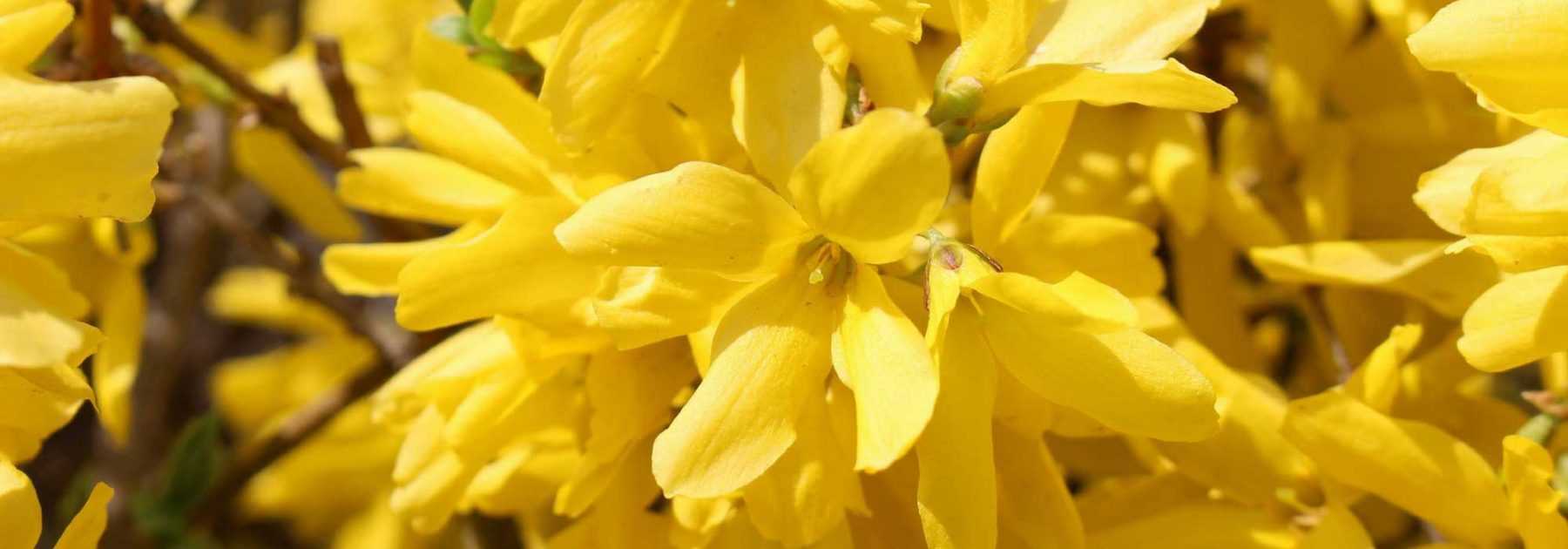
Forsythia: Planting, Pruning and Care
Contents
Forsythia in a Nutshell
- Forsythia is one of the first shrubs to flower in late winter
- It produces a generous display of golden yellow blooms
- It thrives in all soil types
- Compact and hardy, it’s suitable for all gardens
- Perfect for informal hedges, flower beds, borders and containers
Our expert's word
The Forsythia, also known as the Parisian Mimosa, heralds the arrival of spring as early as March, undoubtedly brightening up a dull hedge or flower bed. This radiant shrub is cherished for its abundant golden-yellow blooms that leave no room for leaves, among the first to illuminate the garden after winter’s long slumber.
Today, there are numerous cultivars and hybrids available, including the essential Forsythia x intermedia, which comes in many varieties such as Forsythia ‘Marée d’Or’.
Though sometimes confused with Abeliophyllum distichum and its ‘Roseum’ cultivar or Korean red forsythia, the forsythia remains, despite hybridisation, a yellow-flowering shrub. The foliage, generally deciduous, can be as spectacular as the blooms in some species, with leaves variegated in yellow, green or cream. Its upright, graceful form and moderate size allow for versatile use in all gardens, from the most naturalistic to the wildest, even the most modest.
Whether planted as a standalone specimen, in a flowering hedge (free-form or trimmed), as ground cover in a rockery, in containers or in mixed borders, this highly hardy shrub (down to -20°C) will reveal its splendour as soon as fine weather returns. Graphic and dazzling, its bare branches studded with small yellow flowers are also prized for winter-to-spring bouquet arrangements.
Adaptable and very easy to grow, it thrives in sun or partial shade and grows almost anywhere in any well-drained soil. Robust, original, compact and highly tolerant, discover our forsythias and adopt this essential spring-flowering shrub without delay!

Sometimes considered ordinary by some gardeners, forsythia offers remarkable early flowering.
Description and botany
Botanical data
- Latin name Forsythia
- Family Oleaceae
- Common name Forsythia, Parisian Mimosa
- Flowering February to May
- Height 0.45 m to 5 m
- Exposure Sun, partial shade
- Soil type All types, well-drained
- Hardiness -15°C to -20°C
Belonging to the Oleaceae family, like jasmine and lilac, Forsythia is a charming deciduous shrub, sometimes semi-evergreen, native to Asia, Japan and China.
The Forsythia genus comprises 7 species, and while not all are cultivated, there are very many cultivars and hybrids, including Forsythia x intermedia, also known as the Parisian Mimosa, an essential hybrid resulting from a cross between Forsythia suspensa and Forsythia viridissima, which comes in many diverse varieties.
Forsythia has a dense, bushy habit with numerous often reddish-brown branches that are highly branched and upright, tending to spread with age. While its original form was rather upright, thanks to extensive hybridisation, its shape varies greatly from one species to another, ranging from erect shrubs to compact, rounded forms, arching or even ground-covering varieties like Forsythia (x) intermedia Marée d’or courtasol. Forsythia koreana ‘Kumsun’ differs from other forsythias with its slightly more spreading habit, while F. (x) intermedia ‘Spectabilis’ has a rather untidy appearance. Forsythia Mêlée d’Or ® is a recent and original hybrid variety with foliage arranged geometrically around the stems, giving it a very structured look.
Forsythia generally has rapid growth.
This shrub is divided between arboreal species and ground-covering varieties. Its size ranges from just 50 cm tall for creeping or dwarf varieties to large shrubs reaching about 3 m in height and spread, or even more for the tallest. Ground-covering species tend to self-layer naturally, creating good ground coverage at maturity.

Forsythia viridissima – Botanical illustration
Forsythia has early flowering, among the first in spring. Its flowers are remarkable mainly because they bloom on the previous year’s wood, before the foliage appears, as early as the end of winter when the garden is still bare. From February-March until May for the latest varieties, a profusion of small bell-shaped flowers in bright golden or sulphur yellow, gathered in numerous clusters, adorn the stems. Composed of 4 petals and measuring 1 to 4 cm, they literally cover the bare branches. This often very abundant flowering is, however, relatively short-lived.
In vases, cut branches covered in buds that open into flowers make fresh, cheerful bouquets, heralding the return of fine weather.
Once flowering is over, the deciduous (or sometimes semi-evergreen) foliage takes over in the garden. For some species, it is as attractive as the flowers.
Long leaves, 4 to 15 cm long, opposite, simple, sometimes heavily toothed or entire, sometimes trifoliate, are mostly a beautiful spring green. Today, there are many varieties with remarkable variegated foliage, such as Forsythia ‘Golden Times’ with light green leaves edged in yellow, Forsythia koreana ‘Kumsun’ with tender green foliage variegated with cream and yellow, giving a granulated appearance, and ‘Citrus Swizzle’ with leaves boldly edged in lemon-yellow then cream-white. Often, the foliage turns lovely reddish-purple shades in autumn.
Growing this perfectly hardy and very low-maintenance shrub is extremely simple. It thrives in all well-drained soils and in all climates; it even needs a good dose of sub-zero temperatures to encourage the development of its flower buds. It enjoys sun but tolerates light shade, though it flowers less profusely there.
Forsythia finds its place in all gardens, large or small. It can be grown in free-flowering hedges with other spring-flowering shrubs, in beds or as a standalone specimen. It can even be trained against a wall.
Smaller or ground-covering varieties are perfect for low hedges, rockeries, bed borders as well as in containers.
Main species and varieties
The Forsythia genus includes 7 species, but only a few are commonly cultivated in our gardens. The hybrid Forsythia x intermedia is most frequently found in nurseries, with many interesting varieties available. These differ in their mature size (from 50 cm to around 4 m), growth habit (upright or spreading), which determines their use, and their foliage, which is strikingly variegated in some cultivars (‘Golden Times’). They can be planted as standalone specimens or trained against a wall, in trimmed or informal hedges, as low hedges or on slopes, and even in containers or pots on a terrace for dwarf or ground-cover varieties such as Forsythia x intermedia ‘Marée d’Or’.
Alongside these common species, we offer a range of Forsythias, including some exclusive or less widespread varieties, such as the Korean Forsythia ‘Kumsun’ or Forsythia viridissima ‘Citrus Swizzle’, as well as bare-root options like Forsythia intermedia.
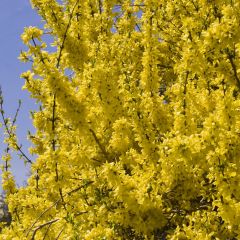
Forsythia intermedia Minigold
- Flowering time April, May
- Height at maturity 1 m
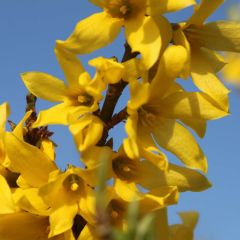
Forsythia intermedia Marée dOr
- Flowering time March to May
- Height at maturity 80 cm
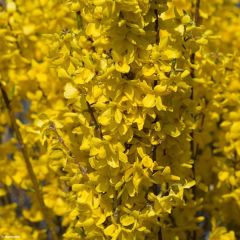
Forsythia intermedia Week-End
- Flowering time April, May
- Height at maturity 2,50 m
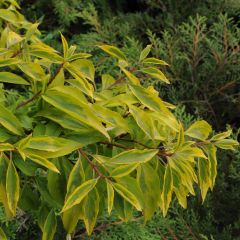
Forsythia intermedia Golden Times
- Flowering time April, May
- Height at maturity 1,50 m
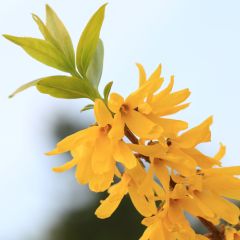
Forsythia viridissima Citrus Swizzle
- Flowering time April, May
- Height at maturity 1 m
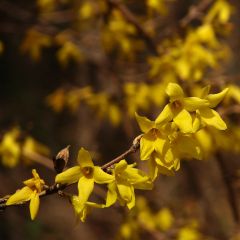
Forsythia koreana Kumsun
- Flowering time April to June
- Height at maturity 1,20 m
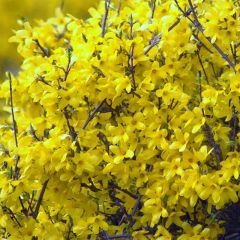
Forsythia intermedia Mêlée dOr
- Flowering time April
- Height at maturity 1 m
Discover other Forsythia
How to plant a forsythia?
Where to Plant a Forsythia?
Forsythia can be planted throughout France, except in Mediterranean climates, which are a bit too hot and dry in summer. Highly hardy, it is capable of withstanding very low temperatures down to -15° to -20°C, ensuring excellent hardiness in all regions. It requires winter frosts to bloom well in spring.
Forsythia prefers full sun, where it flowers best, though it tolerates partial shade. Too much shade may result in a slightly less abundant bloom.
Undemanding, it thrives in any well-drained soil as it dislikes winter moisture. However, it appreciates humus-rich soil that stays cool in summer.
In perennial beds or among spring-flowering shrubs, as a standalone feature, in flowering hedges or in pots on the terrace, Forsythia is compact and suits all gardens. Trailing varieties make excellent ground cover on slopes, as well as edging for beds or low hedges. It can also be planted in groups of 3 or 5 beneath large deciduous trees.
When to Plant Forsythia
Planting is best done in autumn (September–October) or, if necessary, in spring (March–April or May), avoiding periods of severe frost to encourage root establishment before winter.
How to Plant
In the ground
It thrives in well-draining soil where water does not stagnate, especially in winter.
For hedges, space plants 0.60 to 1.50 m apart, depending on the variety.
- Soak the root ball in a bucket of water
- Clear the soil of stones, roots, and weeds
- Loosen the soil and dig a hole 30 cm wide and 40 cm deep
- Add a layer of pumice, river sand, or gravel to the base for drainage
- Enrich half the soil with compost and well-rotted manure
- Plant the shrub at soil level, centring it in the hole
- Backfill while keeping the shrub upright
- Firm the soil around the base
- Mulch to keep the roots cool and weed-free in summer
- Water thoroughly after planting, then once or twice every two weeks during the first growing season
In pots
Choose compact, slow-growing varieties like F. x intermedia ‘Mélée d’Or’. The substrate must be very free-draining to prevent waterlogging. Repot every 2–3 years.
- Place a thick layer of drainage (gravel or clay pebbles) in a pot at least 50 cm wide
- Plant in quality shrub compost mixed with compost
- Mulch the base
- Water well during flowering in summer, then when the soil dries out
→ Learn more about growing Forsythia in pots with Christine’s tips
When and How to Prune Forsythia? What Maintenance Does It Need?
The Forsythia requires little maintenance: a good mulch and light pruning. Although it tolerates poor soils, adding compost or organic fertiliser in spring improves its growth and enhances flowering.
While Forsythia adapts easily to all soil types, it prefers moist, not overly dry soils. In summer, water once or twice a week during heatwaves. To keep the base cool in the growing season, apply a thick organic mulch before spring, especially in the first few years after planting.
Pruning is not essential, except to reshape its silhouette as it matures. It should be done after flowering. For the first three years, a light tidy-up of dead, weak or tangled stems is sufficient. This pruning doesn’t need to be done every year.
Afterwards, prune only every two or three years, always after flowering, by thinning out the centre of the shrub. Cut back spent stems to the base, just above a strong bud.
For shrubs older than three years, remove half or two-thirds of the height of dead, weak or misplaced branches to encourage new growth and rejuvenate the plant. It can withstand even hard pruning down to ground level if you wish to control its spread or reshape it.
Diseases and potential pests
The Forsythia is generally very resistant to diseases and pests when planted in good conditions. In poorly drained soil, it may become susceptible to fungal diseases such as:
- Armillaria (or root rot), a fungus that lodges under the bark and causes root rot, which then spreads to the above-ground parts of the shrub, leading to its death. There is no cure, so the plant must be burned—this is why it’s essential to avoid waterlogged soil when planting.
- Forsythia gall, which causes swellings on the lower stems. This is not dangerous for the shrub. As a preventive measure, at the beginning of winter and early spring, spray with Bordeaux mixture. If affected, remove the infected branches.
Propagation: Taking Cuttings
Forsythia can be easily propagated from softwood cuttings in May-June or semi-hardwood cuttings in August-September.
Softwood cuttings
- In spring, take 10-15 cm long cuttings from non-flowering stems, just below a node
- Remove the lower leaves, keeping only two pairs of upper leaves. Plant them in a light, well-draining mix of coarse sand and potting compost
- Maintain in a warm, humid environment between 18°C and 24°C
- Keep the substrate moist until rooting occurs, which takes 1 to 3 months
- Transplant the cuttings into open ground the following autumn and water well during the first year
Semi-hardwood cuttings
- In late summer, take 10-15 cm cuttings from the slender tip of a semi-ripened current year’s growth (i.e., in transition from softwood to hardwood), just below a bud
- Make a 5 cm long vertical slit in the bark
- Remove leaves from the lower third
- Plant them about 7 cm deep in a well-draining mix of sand and potting compost
- Keep the substrate moist until rooting occurs under a cold frame
- Pot up your cuttings the following spring or plant out in their final position
- Water well during the first year after planting
→ Learn more about propagating Forsythia in our tutorial!
Pairing forsythia
Particularly prized for its burst of luminous yellow in spring, the Forsythia thrives in all natural and wild gardens. King of spring scenes, it pairs beautifully with a multitude of plants that must rival its brilliance and form.
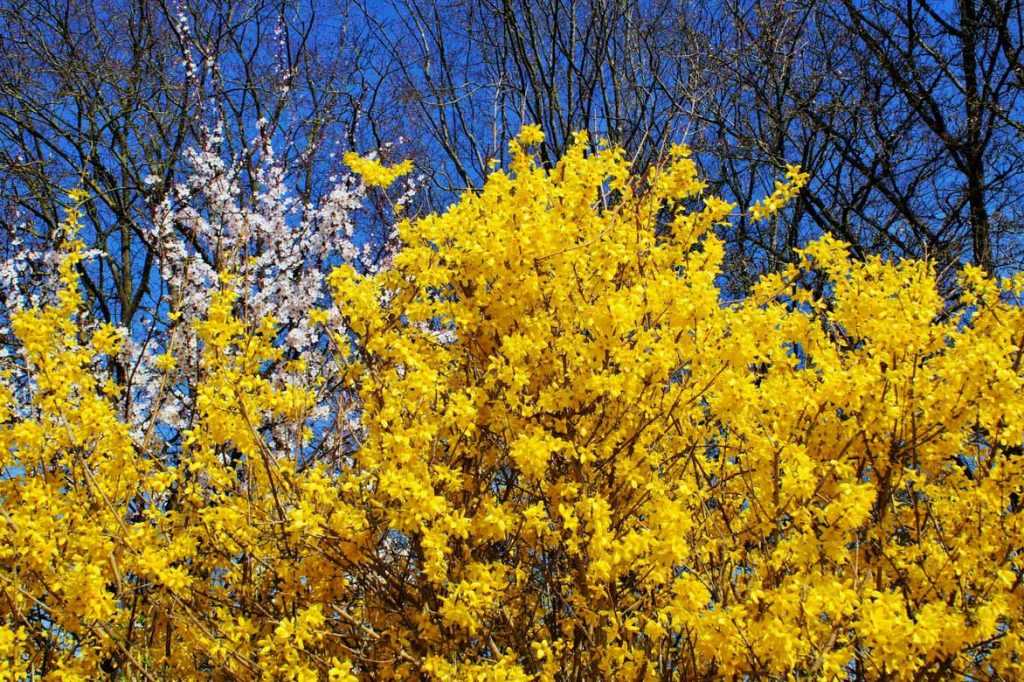
In an informal hedge, forsythia blends well with many shrubs
In a free-flowering hedge, it will be the perfect companion for spring-flowering shrubs such as flowering currants, or alongside Japanese quinces, spirea, deutzia, Japanese kerria, weigela, and lilac.
Planted in groups within borders, alongside its close relative Abeliophyllum roseum, Abelia grandiflora, the smoke bush Cotinus coggygria ‘Golden Spirit’, or mock orange, it will bring a dazzling touch to the still-bare garden. Its bare branches, studded with a profusion of small golden-yellow flowers, will serve as a backdrop for early-flowering euphorbias, early bulbs such as white and pale yellow daffodils, blue hyacinths, or tulips, and will stand out powerfully in gold/white or gold/blue compositions. It creates a lovely contrast against the blue flowers of forget-me-nots.
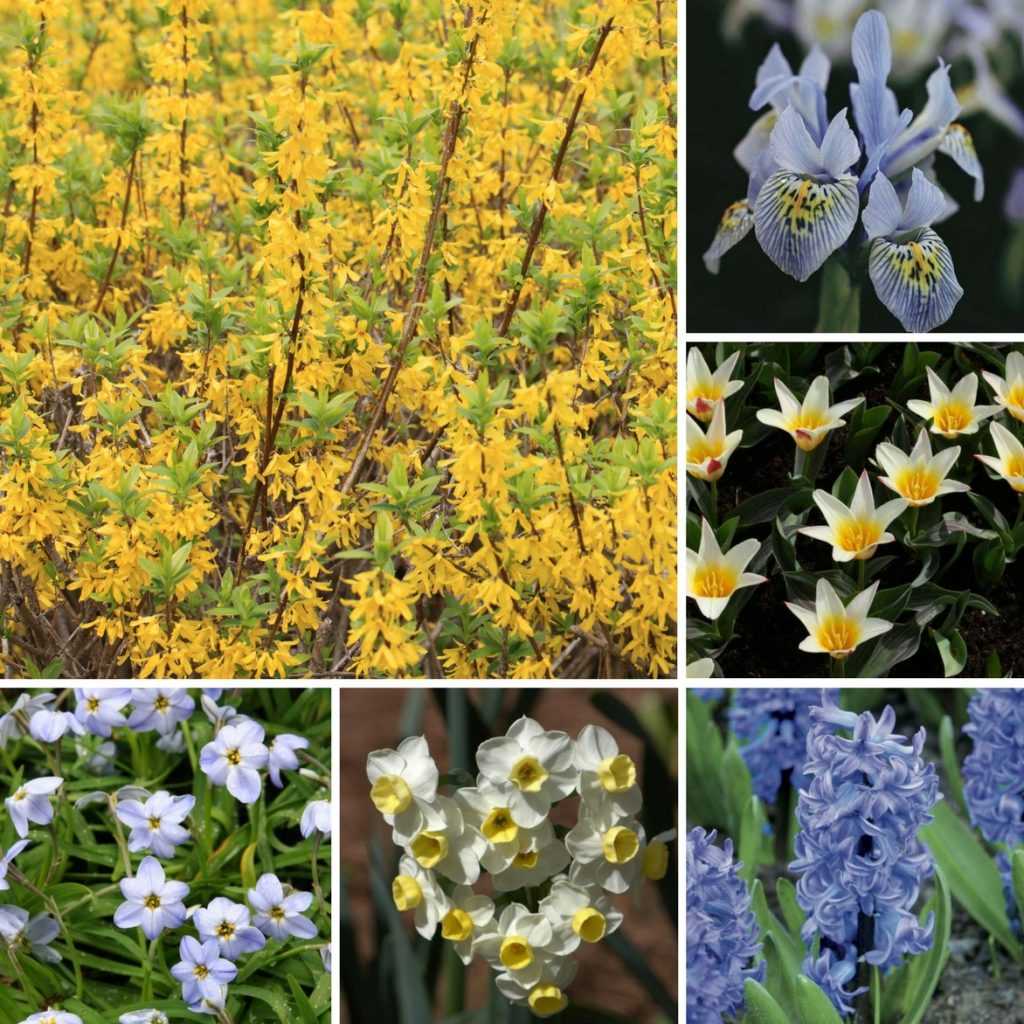
A golden yellow and blue pairing with Forsythia Citrus Swizzle and, from top to bottom, Iris reticulata ‘Katharina Hodgkin’, Kaufmanniana tulip ‘Johann Strauss’, hyacinth ‘Delft Blue’, daffodil ‘New Baby’, and Ipheion ‘Rolf Fiedler’.
Pair it with evergreen shrubs to decorate the garden after the flowers fade, such as Elaeagnus ebbingei ‘Eleador’ with its stunning variegated foliage or Mahonia × media ‘Charity’, hyacinth ‘Delft Blue’, daffodil ‘New Baby’, and Ipheion ‘Rolf Fiedler’.
In low hedges or rockeries, Forsythia ‘Marée d’Or’ will work wonders alongside Cornus canadensis, a tiny dwarf subshrub, or Kolkwitzia amabilis ‘Maradco’, also known as beauty bush, thanks to its bright yellow foliage.
Most forsythias lose their appeal in summer unless draped with beautiful climbers like Lonicera for summer blooms.
Useful resources
- Discover our extensive collection of Forsythias: you’ll find the most popular varieties as well as some rare gems to explore!
- Find our advice on pruning forsythia
- Discover 7 yellow-flowering shrubs
- Choosing a forsythia
- Our tutorial: How to force forsythia branches for bright and colourful bouquets?
Frequently asked questions
-
Can you prune a forsythia? If so, when?
Yes, forsythia tolerates pruning very well, even severe pruning right down to the ground, if you wish to reduce its spread or reshape it. For an adult plant over three years old, cut back at the base, removing between 1/5 and 1/4 of the older stems to encourage the growth of new young stems. Always prune after flowering. Only carry out this type of drastic pruning every 8 years or so.
-
Is there such a thing as a red, pink or white forsythia?
No, despite ongoing research and the emergence and selection of new varieties, forsythias remain shrubs with yellow blooms. However, there is a close relative, Abeliophyllum distichum or white forsythia, which comes in white or pink. Although sharing the same name as forsythia, they are not the same species. Like forsythia, Abeliophyllum distichum flowers at the end of winter, on the previous year's shoots and before the foliage appears. It is a beautiful alternative to yellow forsythia, bringing a touch of white, pink, or red to your garden, balcony, or terrace.
-
The leaves on my forsythia are turning brown, what should I do?
Generally very hardy, Forsythia can become vulnerable to fungal diseases if grown in poorly drained soil. If the leaves of your shrub turn brown, then black, eventually curling up and shrivelling, it is likely affected by phytophthora, a fungus that develops in summer in heavy, water-retentive soils with heat and humidity. Unfortunately, this will gradually weaken the shrub until it kills it outright. There is no cure – remove affected plants to prevent the disease from spreading to others. Be careful not to replant in the same spot. Forsythias grown in containers are more susceptible to this fungus.
-
My forsythia has completely dried up, what's wrong with it?
If the leaves turn grey, dry out and then fall, your shrub has likely suffered from heat stress but can still be saved. Forsythia prefers cool, not overly dry soils. It has low water requirements, except during its first years after planting and in periods of intense heat. In summer, during prolonged drought, water once or twice a week. To keep the base cool during the growing season, apply a good organic mulch (straw, compost...).
- Subscribe!
- Contents



































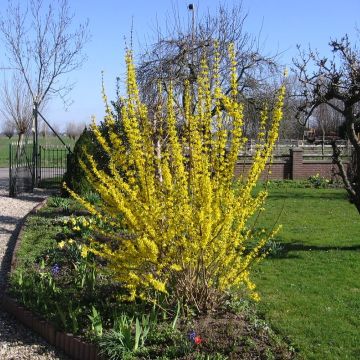
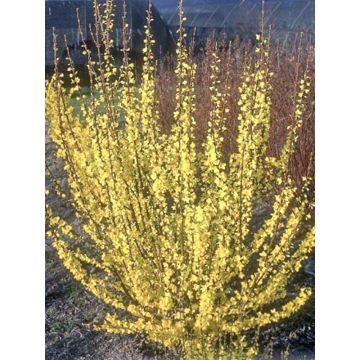






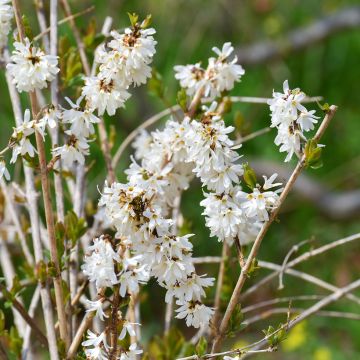
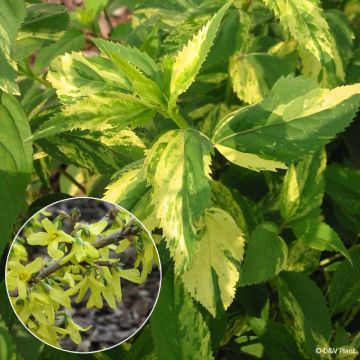
Comments